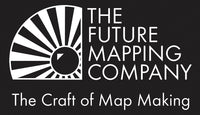Maps of London through history
From hand engraved wood cuts to google maps And Satellites, not only have our techniques for mapping the metropolis Changed dramatically over the past 600 years, so has the landscape of This fascinating city. We've taken a trip back in time to bring you our top 6 maps of London through History, and an extraordinary look at the ever evolving shape of the city.


1. 1560's The Copper Plate Map
The copperplate map is generally considered the earliest true map of London (as apposed to panoramic views). A large scale map, it measured approximately 1 by 2 metres and 3 of the original copper plates (from a probable total of 15) still exist. The map is relatively similar to a smaller and cruder 'woodcut map' formally attributed to Ralph Agas in 1561. See it recreated here.Prints made from the existing plates show a rural view of the city. The Moorgate plate shown here shows pastures surrounding the city buildings. Liverpool Street up to Old Street is home to horses , livestock and windmills rather than big business, banks and internet startups. Meanwhile there is no sign of a market at Spitalfields, just a few archers enjoying the the green space! Click to zoom in on the image to see it in more detail.
A number of maps were reproduced that used The Copper Plate map and Agas map of London as their basis. Here are two fascinating maps that show 'The village of Charing Cross' and the more built up, though still very rural, centre of Westminster.
Taken from engravings of London by John Thomas Smith in 1807, they are based on maps of London from Queen Elizabeth's reign (1533- 1603). A keen engraver and cartographer, he published these maps along with other engravings of London life 'The Antiquities of Westminster' which you can see here in full.
2. 1666 MAP OF London after the Great Fire
In 17th century London, fires were common, but none spread so wide or caused as much damage as the Great Fire of London, which started in a baker’s shop in Pudding Lane on 2 September 1666. London mainly consisted of wooden buildings, tightly packed together along very narrow streets. This, together with dry weather and a strong wind, created the perfect conditions for the rapid spread of the fire. When it finally died out, it destroyed 373 acres of the city, including more than 13,000 houses and 84 churches as well as St Paul’s Cathedral and much of London Bridge.
This map, by Wencelaus Hollar, who had been working on a birds-eye map of the whole city, shows the remains of the city after the Great Fire. The crosses represent the vast central areas that were destroyed.

3. 1746 Detailed map of London by John Rocque
By far the most detailed map of its time was this, 'An Exact Survey of the Cities of London and Westminster, the Borough of Southwalk', printed in 1746. It was created by John Rocque, one of the most important figures in the renaissance of English Cartography and includes every named city and alleyway printed over 24 separate sheets. After the fire, and between 1714 - 1840, London's population swelled from 630,000 to over 2 million, making it the largest city in the world. And among the most powerful.
However, the city depicted is still considerably smaller than it is today with areas like Southwark, Marlybone and Bloomsbury largely undeveloped and Bethnal Green and Lambs Conduit surrounded by fields. This map was sold as a large scale wall map, and as reduced versions for those unable to afford the larger version. It remained unsurpassed for accuracy until the Horwood survey in 1799.
4. 1893 - 1896 Ordnance Survey Maps
The National Library of Scotland recently released some very high res scans of these amazingly detailed maps of the city from 1893-96. You can see the full map here.
Ordnance Survey maps were originally created for Military purposes, hence the breathtaking detail. In the image to the right you can see the individual towers, rooms and staircases, within the Tower of London. While the image of Leicester Square details each alleyway and building.
Although much of the structure of London is strikingly similar to that of the Victorian era, much has changed in the intervening 120 years. The dental hospital is now the Odeon cinema, Tenison Boy's School is Capital FM radio headquarters while the girls school is a TGI Friday! The Kingsland Basin (seen in the final image) has now been renamed “Hertford Wharf” and the warehouses were recently converted to “loft-style” flats. However, the Victorian maps reveal what kinds of products were being moved around: timber, cement, refuse, and plenty of manure.
5. 1936 A - Z of London
Before Google Maps and smartphones, Londoners relied on their pocket A-Zs to get around. The first London A-Z was published in 1936 by an entrepreneurial Phyllis Pearsal. Apparently, she was enroute to a party, yet despite having a 1919 Ordnance Survey map, couldn't locate it. Inspired, the next morning she got up and began to map the city, walking 18 hours per day to check the names and house numbers of London’s 23,000 streets. Once finished, she was unable to find a publisher so set up her own company, the Geographers' A-Z Map Company and self published 10,000 copies.
When WH Smith finally ordered 1250 copies, she said she delivered them herself in a wheelbarrow and only when they sold out did the other retailers catch on – the map has been in continuous production ever since.
Alas, this wonderful myth is refuted by many in the map world who suggest that there were previous street maps of London and she built on that information rather than starting the mapping from scratch as her story would suggest.


6. 2010 Future Map of London
Our fantastically modern city map is a stylised yet highly accurate street map of contemporary London. Fast becoming a design classic, this map shows off every detail of our ancient metropolis in a new light.
Rather than boring monochrome or sepia tones, our map shows the Thames shimmering in watery slate-blue, while parks pop out with gentle apple or bold forest greens. Five categories of cycle routes are prioritised in eye-catching orange and yellow or aqua and lime and famous landmarks such as St Paul's Cathedral, The Shard and the London Eye are illustrated in miniature to help you get your bearings.
The ultimate contemporary update in our long and fascinating history of mapping the Metropolis!










